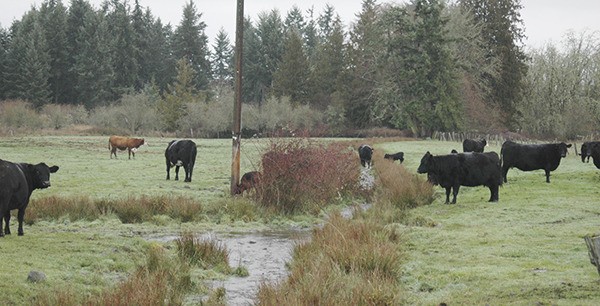Longtime Sequim cattle rancher Robert Reandeau offered his help to obtain the land targeted for an off-stream reservoir along River Road.
“We’re willing to make the investment to at least get the land secured and hold onto it for the reservoir,” Reandeau told the Dungeness River Management Team on Feb. 11.
Since the late 1980s the DRMT, a partnership of representatives from a wide range of stakeholders, such as the Jamestown S’Klallam Tribe, Sports Fisheries and Dungeness Water Users Association, have collaborated to develop and pursue implementation of locally based, long-term solutions to Dungeness Watershed management issues.
Ensuring enough water remains within the river is one of the many watershed management issues the team assists with.
Reflective of the statewide drought that hit the Olympic Peninsula last March, the Dungeness River experienced record low flows, threatening its ability to provide the services, like salmon spawning grounds and irrigation.
In searching for ways to improve water resource management, a network of local and state partners aim to create a reservoir on property managed by the Department of Natural Resources off River Road.
Project partners include officials with the Clallam Conservation District, Washington Water Trust, Department of Ecology, Department of Natural Resources, Department of Fish and Wildlife, Jamestown S’Klallam Tribe, Dungeness Water Users Association, Clallam County and City of Sequim.
Based on several design options, the reservoir could range from 32-88 surface acres, with storage capacities from 550 to 1,586-acre feet.
Early project cost estimates range from $20-$40 million, David Garlington, City of Sequim Public Works director, said.
“The ownership, operation and capital costs are all still big questions,” Ann Soule, City of Sequim water resource specialist, said.
Although the reservoir could be as large as 88 surface acres, the property totals more 300 acres, Joe Holtrop, Clallam Conservation District executive director, said. State officials have expressed an interest in a land exchange for property of equal value, preferably adjacent to existing Department of Natural Resources land.
“DNR isn’t going to want to leave a little chunk (of property), but will want to trade all of it,” Holtrop said.
In order to get the support and funding needed to both build and manage the envisioned reservoir, Holtrop said he anticipates it will need to be “multi-functional.” For example, the reservoir may provide seasonal recreational opportunities, wildlife habitat and be a stormwater management tool.
For ranchers like Reandeau, who farms cattle with his wife Chantelle and in-laws Bill and Janet Stipe, the possibility of a reservoir also holds big potential.
Reandeau expects to benefit from the reservoir as a member of the Sequim Prairie Tri Irrigation Company, but he’s also interested in wintering his cattle on a portion of the 300-plus acres, Reandeau said.
“We’ve been farming here a long time,” he said. “The soils up there hold up and winter cows well.”
Reandeau winters cattle on 120 acres near the proposed reservoir site, but is preparing to lose that land because it’s slated to soon become a “big” subdivision, he said.
Reandeau noted the reservoir as a “complex project” and sees it taking “several years,” yet, he and his family are willing to be an active part of the effort.
“We have and are willing to trade commercial forest property for the DNR land,” he said. “We have a vested interest and want to keep agriculture viable.”
In addition to local support like Reandeau’s, Clallam County Commissioner Mark Ozias has volunteered to take the lead to help push the project at the state level, Holtrop said.
However, before much else can happen, “a final design is the next step,” Soule said.
The final design for the project isn’t complete, but in collaboration with the Washington Water Trust, an environmental consulting firm Anchor QEA of Seattle is preparing a formal proposal for sharing with potential supporters, Amanda Cronin, Washington Water Trust project manager, said.
Already, project partners have applied to the Puget Sound Partnership and to Floodplains by Design and Ecology grant program.



